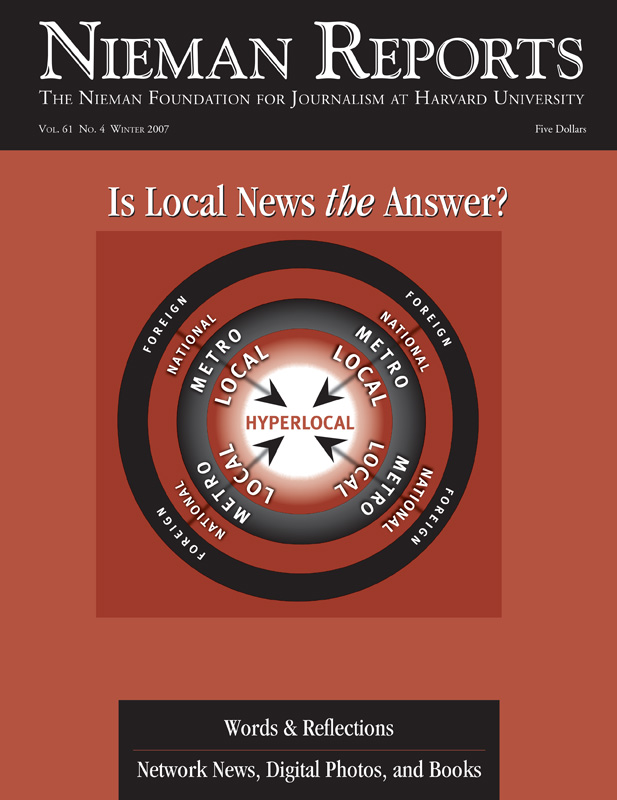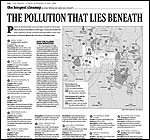Twice a day, editors from across the newsroom of Minneapolis’s Star Tribune gather around a conference table to debate what stories ought to make the front page. We call the meeting the “huddle,” and almost every time it convenes we have to confront a question that seems to get tougher every day: How do we give our newspaper readers stories that are distinct?
The answer, more often than ever, is that we seize on local stories—not national and international news.
That decision does not mean we are retreating from news out of Washington or from coverage of those international events. Every day our pages are still filled with national and foreign stories, usually conveyed to our readers through wire service copy. But the hard truth redefining our priorities is that much of that news is instantly available to readers from a myriad of other sources with whom we aren’t able to compete—from CNN to the Web pages of The New York Times to the aggregated news reports found on Yahoo! News. The newspaper that lands on the doorsteps of our readers cannot look like a retread of the stories that those news media have already broadcast or published a few digital news cycles ago.
There are certainly some exceptions to our emerging local habit, such as when a new Supreme Court justice is chosen or a powerful hurricane hits the Gulf Coast or mass carnage happens in Pakistan or Iraq. But in this time of declining circulation numbers for our print product, it’s become more clear to us that a constant emphasis on substantive local news is most likely to persuade our audience of busy, casual readers that the journalism we exclusively produce truly matters in their lives.
Tilting Local
Our tilt toward local news is not merely manifest in the stories we now put on the front page. The entire newsroom is being reorganized this year around that idea, from reporting beats to our most ambitious journalistic projects. The same focus is also evident on our Web site, startribune.com, where during the past year we’ve created two distinctly local destinations. One new section of the site is called “Politically Connected,” where political reporting covers the national landscape mostly through a local and regional lens. The other, called “Buzz,” launches a daily conversation on a range of local interests and issues. Simultaneously, our newspaper’s editorial pages are working hard to provide unique local commentary.
Like many other newspapers dealing with declining revenues, the Star Tribune reduced its newsroom staff in the first half of 2007 as several dozen reporters and editors departed through buyouts. This exodus required us to overhaul our reporting ranks. This has been a painful process but moving through it nonetheless has given us fresh opportunities. Despite the cutbacks, we still have a veteran reporter in Washington, D.C. covering Minnesota’s congressional delegation, but reporters who were in the features and sports departments have been reassigned to local news. And we’ve created a new health team with the mission of exploring medical and health news in-depth and locally. We also put together four reporting teams whose beats are in the Minneapolis and St. Paul suburbs, where most of our readers live.
Some of these changes are provoking scorn or skepticism from some readers (and some staff members) who are worried that we’re about to start covering pothole problems and school lunch-menu debates at the expense of deep, meaningful stories on local and national issues. There’s no doubt that is a risk. But we are determined to prove otherwise. To do that we need to demonstrate in our pages and on our Web site that local journalism does not mean insular, shallow content. Nor does it mean abusing the notion of “breaking news” by flashing on our Web pages insignificant items that might have 15 minutes of news value.
Instead, we are digging deep, and doing so locally. This fall, four reporters were put on a full-time investigative assignment to look into the collapse of the I-35 bridge near downtown Minneapolis, a mysterious disaster that killed 13 commuters and left many more seriously injured. We also recently published a three-part investigative series on how groundwater tainted with potentially hazardous chemicals still lurks beneath many nearby suburban communities despite the millions of dollars that have been spent struggling to clean it up. And we just took an in-depth look at how the fertility industry has become a freewheeling big business both locally and nationally.
Meanwhile, our enterprise team—a dozen or so reporters—is working to show our readers how issues as diverse as college costs and the Iraq War are rippling out across the region. When we publish these stories, we invite reader comment about them and publish what readers tell us in the newspaper. And what they have to say sometimes leads to more stories.
Our series about groundwater pollution is a model for what we are trying to accomplish. One of our investigative reporters, Dave Shaffer, spent a few months going through piles of arcane records to map out where—and to understand why—local sources of tap water still carry toxic risks. An interactive map on our Web site gave residents in the affected areas the ability to see precisely where the risks exist. We aren’t able to publish this kind of project every week, but we know we can report all kinds of local stories with the same tenacious spirit.
Considering the Odds
With our new game plan, we realize we’re charging down a field lined with obstacles. No newspaper in America appears to have found just the right formula in the digital age—one that attracts new readers and retains the old ones and brings in the revenue needed to pay for journalists to do their work. There are days when I wonder where all of this is headed. But there’s also no point mourning the so-called glory days of newspapers, when profits rolled in and Google sounded like the name of a candy bar. When I look at some of the long-faded front pages hanging on a few walls along our corridors, I see plenty of examples of good journalism. But I also see too many predictable stories and a lack of meaningful attention to issues that deeply affect the day-to-day lives of our readers and their families.
We know what’s not working well: our old habits. And it’s hard to speak with certainty yet that these new steps will reverse our fortunes. But when I sit in one of our afternoon huddles watching the next day’s front page fill up with compelling or important local stories that no one else is reporting, I’m convinced we’re giving ourselves a fresh, fighting chance to keep readers coming back.
Rene Sanchez is deputy managing editor for news content at the Star Tribune.



